Are you ready to add some ethereal elegance to your aquarium? Look no further than the ghost shrimp, also known as glass shrimp.
These captivating creatures are not only visually striking, but they also offer a valuable service to your tank by keeping it clean.
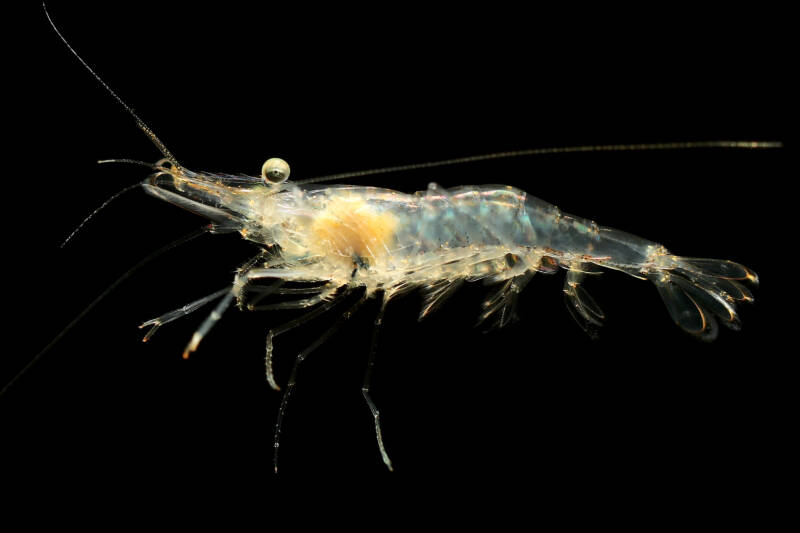
Despite their transparency, they are impossible to overlook in the aquarium due to their unique appearance and behavior.
So why not add a touch of otherworldly charm to your aquatic habitat with these fascinating creatures?
At a glance
| Minimum tank size: | 10 gal (38 l) |
| Water temperature: | 65-85°F (18- 29°C) |
| Lifespan: | 1 year |
| Size: | 2 inches (5 cm) |
| pH: | 6.5-8.4 |
| Hardness: | 3-10 dKH |
| Ammonia: | under 1ppm |
| Nitrite and nitrate: | 0 ppm |
[toc]
Appearance & Temperament
As their name indicates, the body of the ghost shrimp (Palaemonetes sp.) is transparent. Usually, only an orange or yellow spot in the center of the tail breaks this distinctive coloration.
However, some varieties have colored dots along the entirety of their back.
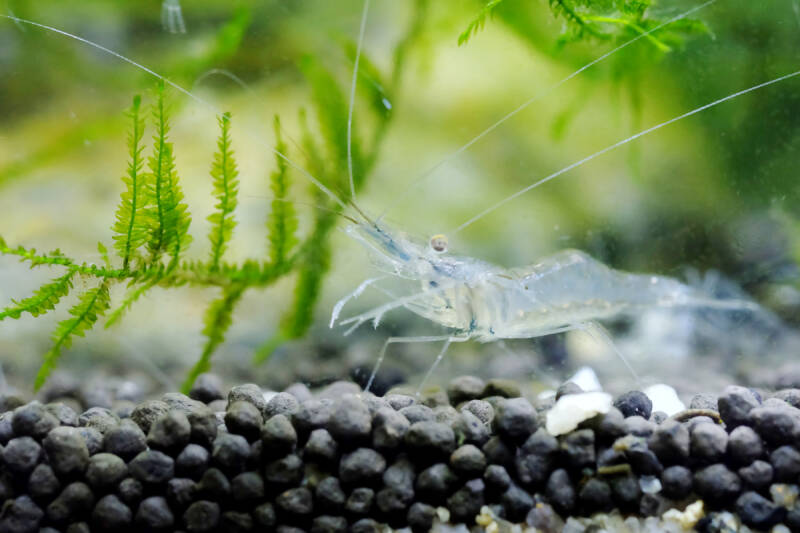
Because of its transparency, you’ll also be able to see colors from inside the shrimp, such as the colors of eggs and digesting food.
Their bodies are segmented and have five sets of legs.
The first two sets also have claws, which help it feed. Other sets also have specific purposes, such as swimming, grooming, and bracing while the shrimp burrows.
They have a large fan tail, another distinct characteristic, in addition to two pairs of antennae and a beak-like growth between their eyes.
Ghost shrimp will only grow to approximately 2 inches (5 cm).

There are no prominent differences between males and females, though females may grow slightly larger.
Still, you’ll be able to clearly see which shrimp are females after they breed, as the green eggs will be visible.
Unfortunately, ghost shrimp only live roughly 1 year before dying. Some aquarists have reported longer lifespans with meticulous care, but only by a few months at most.
Their lifespans are significantly shortened by stress. This most often comes in the form of being transferred to a new tank, dealing with predatory tank mates, and poor water quality.
These shrimp are peaceful and have an easygoing temperament. They are content to simply eat and breed and are not territorial or aggressive.
Origin and Natural Habitat
These are freshwater shrimp and were originally found in the clear waters of North America.
They easily breed and spread. They also don’t need saltwater to breed, and so can even be found in landlocked water. Because of this, it’s hard to pinpoint a more specific point of origin.
Their pervasive presence across the continent also means they’re often considered an invasive species in the wild.
Though they aren’t environmentally destructive, and despite their small size, they can out-compete other bottom dwellers and scavenging species.
Their coloration also makes it harder for predators to find them. This clever evolutionary trait may be fascinating in the aquarium but makes it especially difficult to remove them from wild habitat.
Ghost Shrimp Tank Setup: What You’ll Need
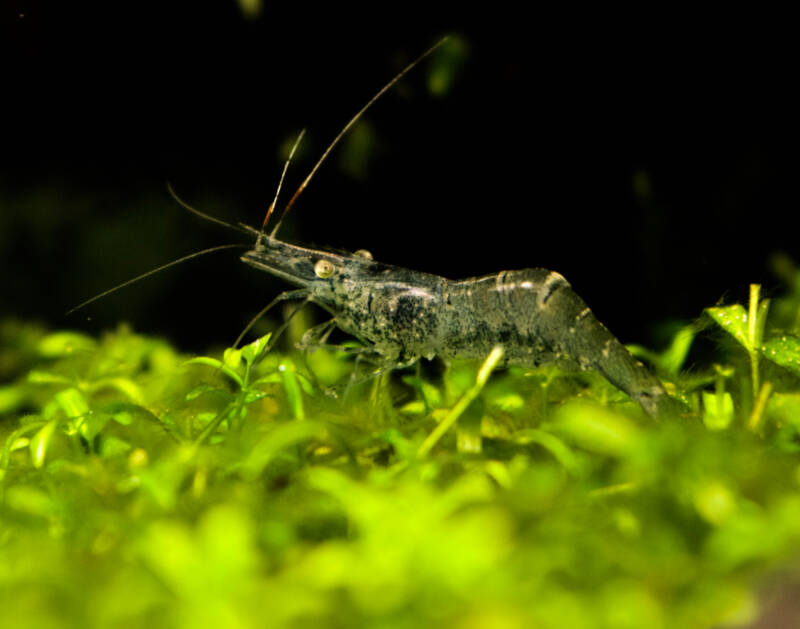
Ghost shrimp need a minimum of 10 gallons for stable water conditions. Depending on the size of the population you want to keep, this may need to be adjusted.
If you want to keep ghost shrimp in a community aquarium, base the gallon size off the needs of the other fish and add an extra 10 gallons for shrimp.
Live plants are the most important component of a shrimp aquarium or a community aquarium with shrimp in it. They provide a food source and a hiding place for shrimp.
Without live plants, your shrimp will not thrive. Because of this, you’ll also need plant-grade substrate and lighting.
With these in the tank, your shrimp are sure to thrive.
Plants and substrate also have the additional benefit of being appreciated by almost every other type of fish, as well.
Adjustments to Aquarium Equipment
Because of their delicacy, some adjustments are necessary to aquarium equipment:
- Filter: In order to avoid sucking your shrimp into filter intakes and outtakes, it’s preferable to use a sponge filter. Barring this, you can also add sponges, screens, and other guards to your filter valves. Shrimp prefer low to moderate water movement, so this modification also has the benefit of keeping the currents at a tolerable level.
- Heater: Since ghost shrimp regularly molt, they often look for protected or hidden spots to shed their skin. Behind the heater is often a favored spot, but can also cause ghost shrimp to get stuck. Either block off the heater, such as in an internal filtration compartment or make sure to regularly check it for guests.
- Tank Lid: Shrimp love exploring, so they’re also master escape artists. They’re avid swimmers and climbers. If your lid isn’t secure or there are large holes around equipment, it’s likely the ghost shrimp will end up outside of your aquarium. Make sure your tank lid is secure and has as few permanent openings as possible.
If you make these easy equipment adjustments and modifications, your aquarium is officially shrimp-ready!
Water Parameters
Shrimp, in general, are less hardy than many fish, and ghost shrimp are no exception. However, they can tolerate a wider range of water parameters than many other types. All of the following ranges below are acceptable:
- pH Range: Ghost shrimp prefer a neutral or basic pH, ranging from 6.5 – 8.4
- Temperature: Warmer water is necessary, heated anywhere from 65 – 85°F
- Hardness: These shrimp can handle water hardness in the range of 3 – 10 KH.
Shrimp are especially susceptible to ammonia, nitrites, and nitrates. For this reason, weekly water changes are absolutely necessary.
Even levels of 2 ppm can be detrimental, so it’s important to try and keep them as close to 0 ppm as possible.
Besides these, ghost shrimp can also be negatively affected by the chemicals in plant fertilizers and aquatic medications. Specifically, copper has been known to cause widespread death in shrimp populations, even in small quantities.
Tank Mates
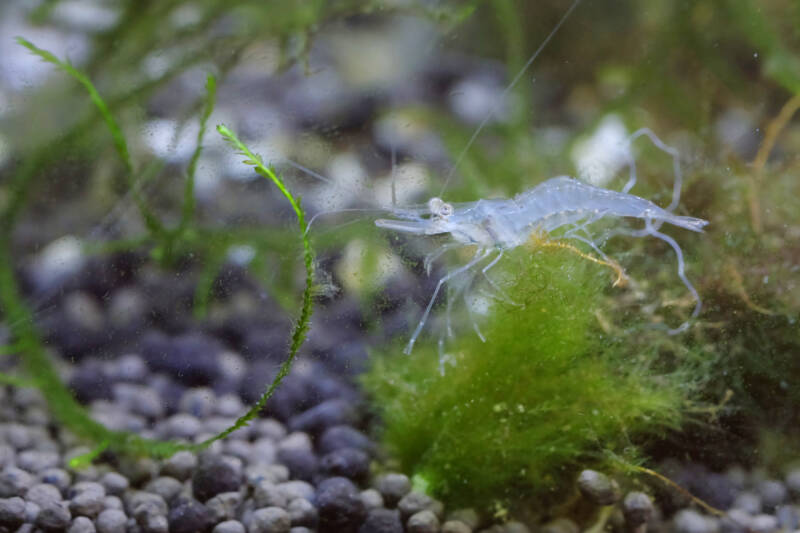
The ghost shrimp has a very peaceful temperament and would get along with almost any fish in a community environment.
However, in these scenarios, it’s not the ghost shrimp that’s the problem, but rather the other inhabitants.
It can be difficult to find suitable tank mates since many fish will see ghost shrimp as food rather than a fellow inhabitant.
To avoid this, there are a few prerequisites for any other fish you place with ghost shrimp.
They must be similarly peaceful and small enough that the ghost shrimp wouldn’t fit in their mouth. Some compatible tank mates that aquarists have had success with include:
- Other shrimp, such as amano and cherry shrimp
- Loaches, such as the zebra loach and kuhli loach
- Non-aggressive catfish and algae eaters
- Schooling fish, such as danios, cherry barbs, tetra, and hatchet fish
- Snails
Many aquarists keep shrimp-specific tanks, in which case there is no threat to the shrimp.
However, ghost shrimp also make excellent (if delicate) community additions.
To create a thriving community tank, more care must be taken when choosing the inhabitants. However, there are still plenty of exciting and varied choices.
Feeding Shrimp and Shrimp as Food
Ghost shrimp are omnivores that will eat almost anything they can get their claws on. This includes food produced specifically for them and food leftover from other tank inhabitants’ feedings.
Some of their favorite foods are:
- Algae
- Plant detritus
- Leftover food
- Flakes and pellets
- Sinking wafers
Since these shrimp are avid foragers, they often don’t need supplemental food.
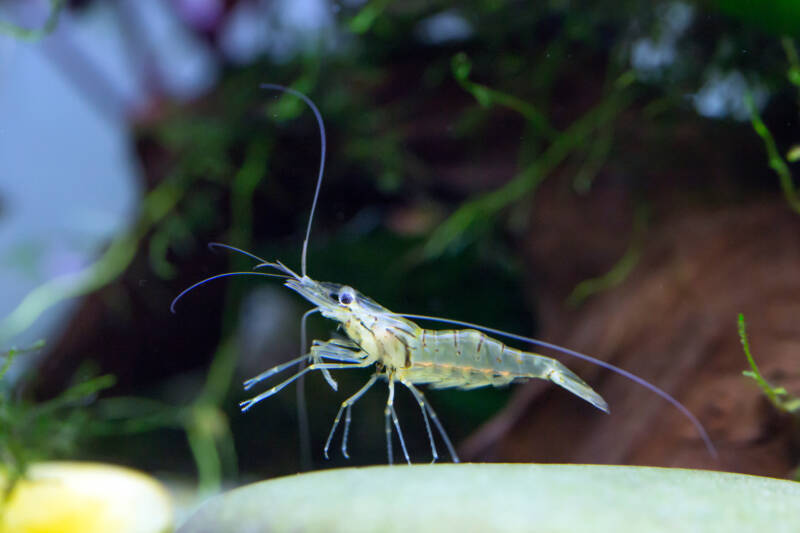
However, if your aquarium is well-maintained and doesn’t have a lot of algae or plant matter, it’s a good idea to provide extra meals.
You can use food that all inhabitants will eat, such as flakes, or food specifically for shrimp, such as sinking wafers or pellets.
You can also use ghost shrimp as part of another fish’s diet. Both freshwater fish and saltwater fish will readily consume ghost shrimp.
This is a problem when housing shrimp in community aquariums, but a benefit if you have any picky eaters.
Even fish that are notoriously reluctant to take food in captivity, such as seahorses, lionfish, freshwater sharks will usually gladly eat ghost shrimp.
Breeding

Ghost shrimp are easily bred in captivity.
They do not require any specialized preparation to induce them to breed. There are only two main requirements which must be met (both of which are present in any healthy aquarium):
- First: the tank must be large enough to support a healthy population of breeding shrimp, in addition to the future offspring. Small groups are much less likely to breed than established populations. Since these shrimp are so small, this usually isn’t a problem.
- Second: the tank conditions must be conducive rather than aversive to breeding. This means that the water parameters should be right, the tank should be clean, shrimp should have plenty of hiding places and food, and there are little to no predators.
If a female is pregnant, you’ll be able to see the green eggs just under her tail. Because of the size, they’ll probably look more like tiny dots, though.
Move pregnant females to a breeding tank and ensure the water quality is perfect. You can also give them supplemental meals to ensure they’re eating enough.
Once the eggs hatch, move the females back to the main aquarium.
You can feed the baby shrimp infusoria, hatched brine shrimp, rotifers, and other liquid foods. Once they are matured, move them to the main tank.
Aquarists should be careful to keep an eye on the size of the population. Though these shrimp are small, they still have an effect on the tank’s bioload.
It can be easy to accidentally overstock the tank if you let ghost shrimp breed as much as they want.
Featuring Ghost Shrimp in Your Aquarium
Ghost shrimp are peculiarly transfixing aquarium specimens.
Their peaceful temperament and determined cleaning make them an excellent addition to almost any tank.
It’s because of these same characteristics that both beginner and experienced aquarists enjoy setting up tanks just with ghost shrimp.
Though they don’t live long, they are a delight to watch and care for.
They may be transparent, but ghost shrimp shine bright as any aquarium.
